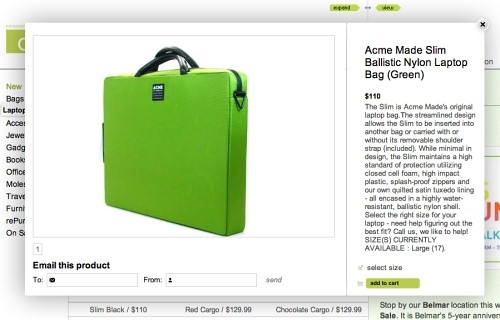Use Conversions To Generate More Conversions
 Behavioral targeting is probably currently the most discussed advertising strategy. However, it is not clear if it possible to derive some meaningful customers’ preferences and future behavior out of the earlier purchasing history. Wrong adjustments – based upon the browsing history – can significantly decrease the conversion rate as well.
Behavioral targeting is probably currently the most discussed advertising strategy. However, it is not clear if it possible to derive some meaningful customers’ preferences and future behavior out of the earlier purchasing history. Wrong adjustments – based upon the browsing history – can significantly decrease the conversion rate as well.If you’ve managed to sell a product to a customer, use this opporunity to present further attractive offers to the customer. The topic “behavioral targeting”, a technique that uses information collected on an individual’s web-browsing behavior, such as the pages they have visited or the searches they have made, to select which advertisements to display to that customers. Many advertisers believe that this technique can dramatically help to boost the conversion rate.
Behavioral targeting is probably currently the most discussed advertising strategy. However, it is not clear if it possible to derive some meaningful customers’ preferences and future behavior out of the earlier purchasing history. Wrong adjustments – based upon the browsing history – can significantly decrease the conversion rate as well.
You may also be interested in the following related posts:
- Design To Sell: 8 Useful Tips To Help Your Website Convert
- 7 More Useful Tips To Help Your Site Convert
- Optimizing Conversion Rates: Less Effort, More Customers
Since you are the owner of an online-store, it’s much easier for you: you don’t have to try to decrypt some general user’s behavior – you can use the concrete data that you’ve collected so far instead. After a purchase your customer has clearly stated his preferences and you have collected some data about him and his interests. And, more importantly, if the delivery of the item didn’t cause any problems, you have gained his or her trust. You can use this advantage to better bind your customers to your company. And this is where personalization becomes important.
Personalization Without “Big Brother”: Keep The Requirements As Low As Possible
If you are not able to convince your users to buy your store items immediately, you need some tools that would develop what marketers call “stickiness”. The latter sees users returning to you within a short period of time and favoring your store over others. Again it’s all about increasing relevancy.
While behavioral targeting works indirectly, lots of other personalization methods work more directly in their attempt to better understand customers’ needs and interests. An easy way to do this is to implement a shopping cart that would store user sessions. Configurations could also be stored, as could previous product comparisons. Being able to print these personalized data sheets might also be beneficial; people who are simply researching products may have different needs than those ready to make a purchase.
 _Shopcomposition.com allows its visitors to put items in the shopping cart without registration. Not all online-stores have the “no-registration-necessary”-policy. It’s not clear why, because most customers do not need to sign up before going into a local store, do they?_
_Shopcomposition.com allows its visitors to put items in the shopping cart without registration. Not all online-stores have the “no-registration-necessary”-policy. It’s not clear why, because most customers do not need to sign up before going into a local store, do they?_
Whatever you do, keep the requirements as low as possible. Tell visitors that their preferences have been saved in a browser cookie, but perhaps don’t go quite so far as to restore an abandoned shopping cart. It would be very important for families to be aware of this lack of privacy. For example, two adults buying Christmas presents for each other might use the same PC. Privacy doesn’t just mean PC privacy; it means personal privacy.
 _Not only allows Perfectorder.jp its visitors to add items to the shopping cart, they can also send an inquiry or ask the customers support for additional information – of course, no registration is necessary. That’s user-friendly._
_Not only allows Perfectorder.jp its visitors to add items to the shopping cart, they can also send an inquiry or ask the customers support for additional information – of course, no registration is necessary. That’s user-friendly._
Any form of personalization starts with a basic registration, that is with an email address and password. That is learned behavior and doesn’t do much harm. Intelligent systems use this first conversion to immediately trigger a second conversion. They could use it to send out a discount coupon that customers may only be able to redeem by revealing more personal information.
Make Use Of The Neglected Thank-You Page
As mentioned above, the time after a conversion is the best time for the next one. If a user finally made a decision to buy an item and finished the checkout process, he or she already agreed with your payment and delivery methods. This is why this is the perfect time to prepare the customer for the next purchase.
You have already collected important data from the user and earned the user’s trust. It is truly interesting that not many online stores use a proper thank-you page, the page that users are redirected to upon checking out. Thank-you-page is the perfect place to advertise a newsletter. Advertising is the key: tell your customers what value they can get by disclosing their email address.
You can also use this opportunity to trigger an attractive marketing trick. How about a countdown, let’s say 60 minutes, and promising free shipping for all orders completed within that time frame (read also the article Free Shipping increases trust)? You could provide the readers with a peek at next weeks’ hot sales or suggest some special offers or sales. You could mention products that other customers have bought in addition to the one just purchased. You could offer a coupon for an upcoming sale. You could lead customers to the members area, inviting them to store their shipping address so that their next purchase is easier.
Good Service Is The Best Viral Marketing
Of course, you need to offer your products at a convenient, yet competitive price, otherwise your shop-optimization won’t do any good in the first place. However, if you do have reasonable prices, the principles and guidelines listed in the last three articles are very likely to improve customers’ user experience and boost your conversion rates.
To improve your position against your competitors, you need to make sure that you provide a good product description or offer a better fulfillment-service. The first one depends on the branding and the quality of the products that you offer; the latter one has an enormous impact on the reputation of your store.
If you are providing a good service for a long period of time, you’ll be able to reap the benefits of the so-called “cognitive relief” – the latter describes the phenomenon when a user, being a loyal and satisfied customer for a more-or-less long period of time, starts to ignore alternative choices and returns to your store over and over again, believing that she found the right one – the one that perfectly fits their needs and provides a really good service. It is very likely that these users also spread or initiate the word of mouth advertising which brings you even more customers in a long run.
Bottom line: whatever optimization methods you are using, you should never compromise your quality of service and the performance of your store. The more responsive you are, the less reasons your customers will have to switch retailers. If you need a reason for Amazon’s success, this is it.
Make sure your customers know exactly what stage they’re at in the purchasing process. Allow them to track their order. Encourage them to rate your store, leave a testimonial (perhaps rewarding them with a coupon) or recommend the store to their friends. Oh, and of course don’t forget the social media. There is no better viral marketing technique than a plain ol’ good quality service.
Related posts
This article is the last part of our 3-part-series “Optimizing Conversion Rates”.
- Optimizing Conversion Rates: Less Effort, More Customers
- The Conversion Is All About Usability
- Use Conversions To Generate More Conversions
You may want to subscribe to our RSS-feed ![]() and follow us on Twitter
and follow us on Twitter ![]() for more articles about usability, design and marketing. Any ideas or suggestions? Comment on this article!
for more articles about usability, design and marketing. Any ideas or suggestions? Comment on this article!








